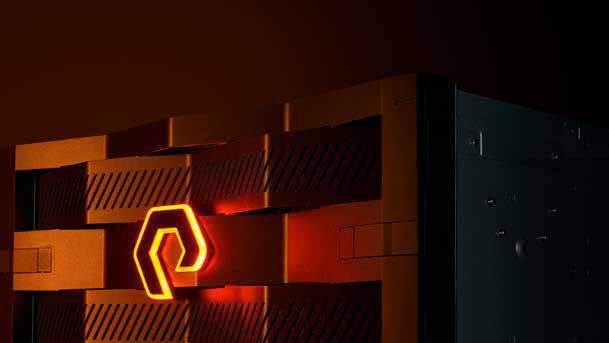Pure Storage CEO: NetApp, Dell, HPE Aren’t True Cloud Storage
‘[HPE GreenLake and Dell Apex] are just financial models to enable customers pay a subscription for storage rather than as capex. Or rather it‘s really more like a lease model in most of those cases. Whereas we’re bringing technology into the data center that allows the customer to both manage and to offer storage services and data management to their developers as APIs,’ says Pure Storage CEO Charles Giancarlo.

Upping The Storage Ante
Pure Storage has had a stunning ride from a startup all-flash storage array vendor a few years ago to become today one of the top storage vendors and only one of two major standalone storage developers. The growth of the Mountain View, Calif.-based company stems from a early decision to focus on developing software optimized for flash storage rather than commodity SSDs, and on hardware optimized to run that software, according to Pure Storage CEO Charles “Charlie” Giancarlo.
Giancarlo, in an exclusive meeting with CRN, said Pure Storage’s approach to making storage capacity on its all-flash storage arrays available as pooled storage available for use anywhere from on-premises to public and private clouds is different from that of its competitors. Technologies like Dell Apex and Hewlett Packard Enterprise GreenLake are little more than changes in how storage is financed, and both along with NetApp still require storage to be tied to an application stack.
“With our competitors’ arrays, the customers are still taking the storage systems, physically tying them to their application environments, managing them on their own,” he said. “And when their developers need storage, there‘s a lot of manual processes in the middle for the IT department to offer storage to the developers for a new application environment.”
[Related: PURE STORAGE CEO: NO STOPPING EVOLUTION TO CLOUD, FLASH]
Pure Storage, on the other hand, makes storage services available as needed via APIs, Giancarlo said.
“We provide a software management environment whereby IT defines a set of data storage services for their developers, and then the developers get access to them via APIs,” he said. “No need for a phone call, no need for physical rearrangement. It‘s very similar to the way Amazon or Azure offers their storage services, but [they do it] just within those clouds. We do it across the hybrid cloud.”
Given Pure Storage’s growth, it’s not unreasonable to expect the company to eventually rise to the top of the storage industry despite its competitors’ much larger sizes, Giancarlo said.
“We‘re the one company that looks at data storage like it’s high technology rather than a commodity,” he said. “And we’re the one company that‘s looking to bring a cloud operating model to the private and hybrid cloud world by allowing data to look to the IT organization as just a pool of storage, and allows their developers to get access to data storage via APIs.”
For a deeper dive into Pure Storage and into Giancarlo’s thoughts on the storage industry and the changing macroeconomic environment, click through the slideshow.

How do you define Pure Storage?
I would say that we are the sole best of breed vendor of data storage and management solutions to enterprises worldwide. We‘re the one company that looks at data storage like it’s high technology rather than a commodity. And we’re the one company that‘s looking to bring a cloud operating model to the private and hybrid cloud world by allowing data to look to the IT organization as just a pool of storage, and allows their developers to get access to data storage via APIs.
B ut isn’t that something that a lot of other vendors, including in the storage industry, are doing? NetApp has been talking about the cloud longer than anybody. Or Dell Apex, or HPE GreenLake. Aren’t these other companies doing that as well with their storage?
No, as it turns out. Let‘s take GreenLake and Apex. Those are just financial models to enable customers pay a subscription for storage rather than as capex (capital expense). Or rather it’s really more like a lease model in most of those cases. Whereas we‘re bringing technology into the data center that allows the customer to both manage and to offer storage services and data management to their developers as APIs. In other words, Dell and HPE are still just offering the same old arrays, and now you can just pay for them on a monthly basis rather than as capex. But they’re still tied to specific application stacks. Individual arrays tied to individual application stacks. We allow all the storage in an enterprise, within a private data center, across the private data centers, across the private as well as the public clouds that our customers are managing, to be accessed as a single pool of storage via API.
So think of it this way: With our competitors’ arrays, the customers are still taking the storage systems, physically tying them to their application environments, managing them on their own. And when their developers need storage, there‘s a lot of manual processes in the middle for the IT department to offer storage to the developers for a new application environment. In our case, we provide a software management environment whereby IT defines a set of data storage services for their developers, and then the developers get access to them via APIs. No need for a phone call, no need for physical rearrangement. It’s very similar to the way Amazon or Azure offers their storage services, but [they do it] just within those clouds. We do it across the hybrid cloud.

How does that differ from NetApp’s approach to the cloud?
NetApp doesn‘t do that at all. Again, NetApp will sell you their arrays, or you can use their arrays inside of Azure or AWS. But you’re still physically using their arrays. And if you use it on-site, their arrays are still attached directly to an application stack. They‘re not networked across the enterprise.
It‘s incredible how antiquated data storage still is in most cases in the enterprise. Do you remember the external data storage, the external disks that you could buy that you plug into your desktop or your laptop? You might even still have one. If you think about that external disk as a storage array, it’s very much the same, which is that it‘s tied to a specific application stack. It’s not truly networked across the enterprise such that a new set of users can get access to it, because that that array is tied to a specific stack. We‘re the first ones to come out with the software that allows a full fleet of arrays to be utilized as a single pool of storage.
Just to extend the analogy a bit further: Just like those external hard drives, our competitors, instead of selling you the external hard drive, will now rent them to you. What we‘re doing is the equivalent of Dropbox. Our customers now have the equivalent of Dropbox, where they don’t worry about the size or attaching it to any one thing. They can use it across all of their developers. And if they need more, they just ask for more. And if they need less, they ask for less. And it‘s all automatic. It’s all via software.

You’ve talked a lot about the software side of Pure Storage’s business. How important is software versus hardware in terms of development at Pure Storage?
Well, 95 percent of our of our engineering team is in software. That should give you a pretty good sense. I don‘t know how to express it any more than that. But I will say that the hardware is particularly important to us to enable our software to be able to get the most out of the storage environment. And what I mean by that is simply that we utilize less power, space, cooling, and we require fewer materials, resulting in less e-waste than any competitor out there by quite a large degree. There are two reasons we’ve been able to do that. One is, we design our software specifically for flash and to make the best use of flash, and the most efficient use of flash. And we couldn’t do that if we were using commodity SSDs and commodity servers. So we‘ve optimized our software for flash, and our hardware has optimized the flash for our software.
Is that different than the way your competitors approach hardware versus software?
Well, first of all our competitors started with products that of course had their history in the hard disk era, right? And in order to build all-flash systems, all they did was replace the hard disks with SSDs. SSDs are flash devices specifically meant to make flash look like a hard disk so that minimal software change was necessary. And because of that, our competitors are not able to have the efficiency of operation or even the performance for the same level of investment that we‘ve been able to achieve. It’s also why, for example, we‘ve been the only one, even after two years, to have a product that can address the cost characteristics of second-tier storage, tier-two storage, with our FlashArray//C.

Recent reports say that Pure Storage, in terms of flash systems sales, has actually been growing faster than the industry, and faster than probably anybody else in the industry. What’s behind that growth?
Well, it‘s really just the entire company that’s growing. We‘re growing both of our hardware-based products, FlashArray and FlashBlade. We‘ve been growing with Cloud Block Store [enterprise cloud storage architecture] and Portworx [Kubernetes storage]. Last quarter, we grew 50 percent year-over-year. I think not one of our competitors grew by more than a single digit percentage year-over-year. And many of them were flat to down. So we‘re seeing enhanced growth.
I really attribute it to two things. One is a broad product line that we‘ve developed during the COVID period, and somewhat before. So we’ve really broadened our product line. And then we‘ve matured the company overall so that we can address not just the commercial market and the enterprise market, but now even the cloud market. All three of those have been quite strong for us over the last multiple years. We’ve really become a full-scale broad supplier to enterprises of all sizes, and we can support a very large fraction of their storage needs because our superior technology has really allowed us to grow very rapidly.
Could you see Pure Storage becoming the No. 1 provider of storage arrays and in the near future revenue-wise?
We’re steadily climbing up the market share ladder. We were, well, probably nowhere five years ago. We‘re probably in the number four spot now, I think, very much in line to take over the number three spot. We’re already way up there at number one or two in the all-flash segment. So we very much aspire to be one of if not the most significant player in the storage market. But we have competitors that are many times our size that we still have to overtake.
Are you ready for the day that Pure Storage maybe becomes number one, and everybody starts pointing to Pure Storage as their target and their goal to beat?
We‘re already the target of most of our competitors right now because we don’t compete in the same way they do. When I joined the company just five years ago, in doing my background research on the company, everybody, including all of the competitors, pointed to data storage, saying it’s a commodity, and it was a race to the bottom. And our competitors have invested in it as if it were such, spending less than 5 percent of their revenue on R&D. And we‘re the one company that looks at data storage and management as high technology. We’ll invest this year about 20 percent of our revenue in R&D. And so, I think that really sets us apart. We play a very different game from our competitors. And so far, it’s working for us.

The macroenvironment is changing. For instance, talk about the huge talent shortage has given way to increasing layoffs at tech companies. In terms of the macro environment, what are you seeing?
Very similar. The bubble is always the biggest before it bursts. And we saw this back in the year 2000 and 2001. And it went from various people looking at jobs they felt very entitled to to the comic in the Wall Street Journal of an engineer sitting on the street with a sign up saying, ‘Will work for benefits.’ So, I don‘t know that we’ll see quite the same thing. But certainly the talent shortage, it doesn‘t really exist anymore. We’re seeing more and more people wanting to come to Pure, and wanting to come back to Pure.
Now, in terms of the market overall, it‘s still it’s hard to say. It‘s still early. Digital transformation is still very much at the forefront of thinking of enterprises, both in the U.S. as well as worldwide. But certainly, we’re cautious about the second half of the year. We are certainly going to keep our eyes open.
What are some things that Pure Storage is doing to prepare for changes in the macro environment, the changes that are starting to happen already?
Well, honestly, we‘re continuing to stick to our plan, which is growth this year. We still feel very good about the plan that we have in place. We continue to hire to that plan. But certainly, we’ll be we‘ll be cautious to make sure that we don’t overshoot.